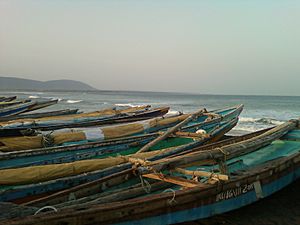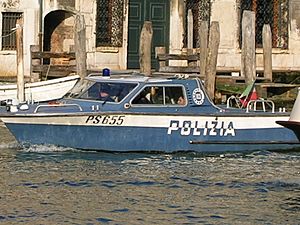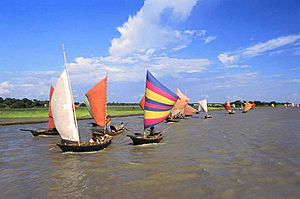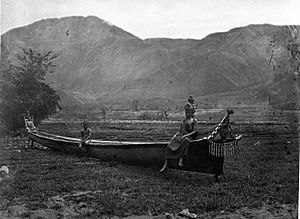Boat facts for kids
A boat is a vehicle used to travel on water. It is usually smaller than a ship. A boat can often be lifted out of the water and carried on a ship. Some boats have sails, some are moved by oars, and some use motors.

Most boats are made of wood. However, some parts use metals like steel and aluminium. More expensive boats might have parts made from fiberglass or composite materials. Some special boats can even go underwater. These are called submarines.
Contents
History of Boats

Boats have been used for transportation since ancient times. Archaeologists have found evidence that boats were used over 40,000 years ago. This suggests people used them to settle places like Australia.
The oldest type of boat found is the logboat. These are made from hollowed-out tree trunks. The oldest recovered boat is the Pesse canoe. It was made from a Scots pine tree between 8200 and 7600 BC. You can see this canoe in the Drents Museum in Assen, Netherlands.
Simple rafts have been used for at least 8,000 years. A 7,000-year-old seagoing reed boat was found in Kuwait. Boats were common between 4000 and 3000 BC in places like Sumer, ancient Egypt, and the Indian Ocean.
Boats were very important for trade. For example, they helped connect the Indus Valley civilization with Mesopotamia. Ancient Arabs and Greeks also used large wooden boats, like the Uru craft from India, for trading. Historians like Herodotus wrote about boats used for trade, travel, and war.
Types of Boats
Boats can be put into three main groups:
- Unpowered or human-powered boats: These include rafts and floats. They are often used for one-way trips downstream. Human-powered boats include canoes, kayaks, gondolas, and boats moved by poles, like a punt.
- Sailboats: These boats are moved only by their sails, which catch the wind.
- Motorboats: These boats use mechanical power, usually from engines, to move.
Parts of a Boat
Most boats have several key parts. The hull is the main body of the boat. It helps the boat float. The gunnel forms the sides of the boat. It helps keep water out and makes the boat harder to sink.
The flat, horizontal parts inside the hull are called the deck. A ship might have many decks, but a boat usually has only one, or none. The structures above the deck are called superstructures.
An enclosed space on a boat is a cabin. The "floor" of a cabin is properly called the sole. The walls inside a cabin are called bulkheads.
The keel is a strong part that runs along the bottom of the boat, from front to back. It's like the boat's backbone.
The front of a boat is called the bow. The back of the boat is called the stern. If you are facing forward on the boat, the right side is starboard and the left side is port.
Most boat owners give their boat a name. This name is how the boat is known in the boating world and in official papers. Boat names can be funny, serious, or creative!
Building Materials
For a long time, most boats were made from natural materials. These included wood, reed, bark, and animal skins. Early examples are the reed boats of Ancient Egypt and the birch bark canoe. There were also animal hide-covered boats like the kayak and coracle. The dugout canoe was made from a single log.

By the mid-1800s, some boats started to have iron or steel frames, but still used wood for the outer layers. Later, in 1855, a method called "ferro-cement" was invented. This used a steel wire frame covered with cement. These boats were strong but heavy.
As steel became cheaper, boats made entirely of steel became more common. By the 1930s, steel boats were used for many industrial jobs and fishing. In the mid-1900s, aluminium became popular. It was more expensive than steel, but lighter and didn't rust in salt water.
Around the 1960s, boats made of glass-reinforced plastic, or fibreglass, became very popular. This was especially true for boats used for fun. Fibreglass boats are strong and do not rust or rot. They are often covered with a smooth, colored layer called gelcoat.
Another way to build boats is "cold moulding." This uses thin strips of wood layered with epoxy or polyester resin. Each layer is glued to the next until the hull is thick enough.
Some boats are also made from foam or plastic. Many boats built at home today are made of plywood. They are then painted or covered with fibreglass and resin.
How Boats Move
Here are the most common ways boats are moved:
- Engine-powered propellers:
* Inboard (engine inside the boat) * Inboard/outboard (engine partly inside, partly outside) * Outboard (engine completely outside, usually at the back) * Paddle wheel (large wheels with paddles) * Water jet (used in jet skis and jetboats) * Air fans (used in hovercrafts and air boats)
- Human power: This includes rowing with oars, paddling with a paddle, or using a setting pole.
- Wind power: This is when a boat uses sails to catch the wind and move.
One old and unusual way a boat moved was called the water caterpillar. It had a series of paddles on chains along the bottom. These paddles pushed the boat over the water.
Why Boats Float
A floating boat pushes away, or displaces, its own weight in water. Even if the boat's material is heavier than water, the boat itself is mostly air inside. So, the total weight of the boat (and everything in it) spread out over the volume of water it pushes away is equal to the weight of that water.
Think of it this way: if a boat floats, the amount of water it pushes aside weighs the same as the boat itself. If you add more weight to the boat, it sinks a little deeper. This makes it push away more water until the weight of the water pushed away again matches the new, heavier weight of the boat.
Images for kids
-
These dugout boats were photographed in the courtyard of the Old Military Hospital in the Historic Center of Quito.
-
A boat on the Ganges River.
-
Babur crossing river Son; from an illustrated manuscript of ‘Babur-Namah’, Mughal, Akbar Period, AD 1598.
-
A ship's old lifeboat, made of steel, rusting away in the wetlands of Folly Island, South Carolina, United States.
-
Ming Dynasty Chinese painting of the Wanli Emperor enjoying a boat ride on a river with guards and courtiers.
-
A boat shaped like a sauce bottle that was sailed across the Atlantic Ocean by Tom McClean.
-
Boats for rent in Germany.
-
A recreational motorboat with an outboard motor.
-
Silver model of a boat, tomb PG 789, Royal Cemetery of Ur, 2600-2500 BCE.
See also
 In Spanish: Bote para niños
In Spanish: Bote para niños




















